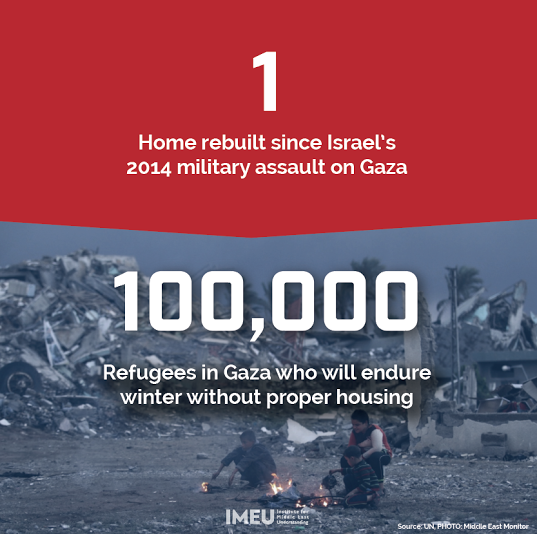Consider the above statistic. It’s truly shocking.
It’s also a lie. Since the end of Operation Protective Edge, over 3 million tonnes of construction materials have entered the Gaza Strip through the Kerem Shalom crossing with Israel. This has enabled, to date, 104,587 damaged homes to be fixed, and 3,764 totally destroyed homes to be rebuilt.
All this has happened through the Gaza Reconstruction Mechanism. This trilateral mechanism was established at the end of the last war; it is officially led by the Palestinian Authority, supported by Israel and supervised by the United Nations. It is a system for facilitating the delivery of construction materials to householders whose homes were damaged in the last war or to projects advanced by international sponsors. It provides a creative, though not foolproof, means of enabling the delivery of much-needed building materials to the people whilst making life difficult for Hamas to get its hands on such materials, as it continues building tunnels into Israel and rearming itself. Israel works in tight coordination with UNOPS inspectors to prevent any leakage.
The primary problem facing reconstruction today is the lack of international donor funding. At the October 2014 Cairo Conference, states pledged $3.5 billion to support reconstruction. Of this sum, much of it double-pledged anyway, only 35% had been disbursed by the end of August 2015. As a result, reconstruction is far behind what Israel wants to see and has indeed planned for. The UN’s Office for the Coordination of Humanitarian Affairs (UNOCHA) states baldly: “Despite the generous pledges… a funding gap still exists for the reconstruction of over three-quarters (9,200 units) of the totally destroyed homes.”
The evidence is in the numbers. In Gaza today, there are 319 large-scale international projects underway. But Israel has approved 511 projects through the GRM. The gap of 192 schools, clinics or housing units not being built is a product of the international community’s failure to meet its own funding pledges. As Hamas continues to rearm and bore new tunnels, it is hardly surprising that the world fears another round of violence, which would jeopardise their investments.
Lack of funding is one of the reasons for the absence of adequate energy provision to Gaza. The Strip receives annually some 120 MW of electricity through Israel, four times as much as from Egypt. Gaza’s own power plant produces some 60 MW a year. Gaza could more than double its domestic production of electricity, if money could be found for daily flows of diesel to fuel the plant. But nobody wants to pay.
Last month, the Coordinator of Government Activities in the Territories – the IDF unit in which I served – held a briefing at the Foreign Ministry for foreign ambassadors. When the floor was opened to questions at the end, the only person who spoke was the UN Special Envoy, Nickolay Mladenov. He did not attack Israel for retarding the reconstruction efforts. On the contrary, he lauded Israel for its good work and appealed to the assembled ambassadors to increase their countries’ donations.
When I served in COGAT, diplomats would tell us behind closed doors that they were “shocked” by how much reconstruction was happening in Gaza. “It is obvious,” confided one senior UN official to us, “that Israel is the actor that cares most here about the reconstruction of Gaza.”
The problem is not from Israel’s side. When it comes to applications to build new housing units, Israel has not rejected a single application from the Palestinian Authority. The homes that have not yet been rebuilt are homes for which the Palestinians have not yet requested the importation of construction materials through Israel. When they do, the materials will flow: in the last year alone, the number of trucks transiting daily through Kerem Shalom has leapt from around 300 to nearly 900 – the result of millions of shekels of investment by Israel in expanding the crossing’s capacity. The crossing is being expanded further, including the installation of a new cargo scanner generously donated by the Dutch.
Israel’s policy today is maximally permissive. It is possible today to import anything into the Strip, other than items that could have military applications (so-called “dual-use” items). These are not banned, but rather imported daily subject to a strict security assessment.
There is indeed a naval blockade, to foil the delivery of war materiel to a territory controlled by a hostile terrorist entity, but anything that has business entering Gaza does so through Israel’s crossings. The Rafah crossing with Egypt is basically sealed, a result of Egypt’s decision to cut itself off from the Gaza Strip, humanitarian consequences be damned.
The situation in Gaza remains unpleasant, to say the least, for the people left homeless as a result of Hamas’s strategy of using densely-occupied residential areas as a launchpad for rockets in the last war. Many of them will endure winter in temporary accommodation, such as the 300 pre-fabs donated by Oman and delivered through Israel.
If pro-Palestinian activists are interested in providing relief for the people of Gaza, they are welcome to donate pre-fab housing or donate for the construction of permanent accommodation. Israel would love them to do so. What a tragedy that certain agents – the above infographic was published by the ironically-named Institute for Middle East Understanding and shared by Jewish Voice for Peace – prefer to publish lies instead. Talk is cheap. Reconstruction costs money.
Article Source: http://blogs.timesofisrael.com/the-shocking-facts-behind-the-reconstruction-of-gaza/










